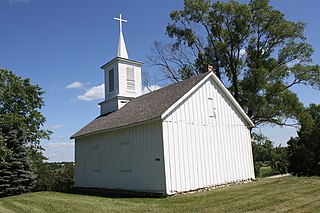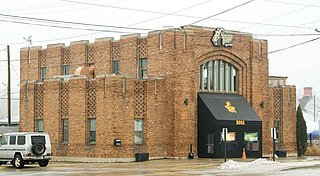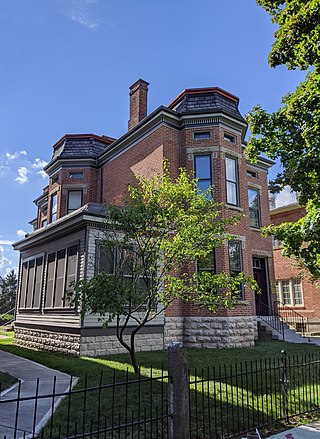
The Circus World Museum is a museum complex in Baraboo, Wisconsin, devoted to circus-related history. The museum features circus artifacts and exhibits and hosts daily live circus performances throughout the summer. It is owned by the Wisconsin Historical Society and operated by the non-profit Circus World Museum Foundation. The museum was the major participant in the Great Circus Parade held from 1963 to 2009.

City of Houston Fire Department (HFD) is the agency that provides fire protection and emergency medical services for the city of Houston, Texas, United States, the fourth largest city in the United States. HFD is responsible for preserving life and property for a population of more than 2 million in an area totaling 654 square miles (1,690 km2). The department is the largest fire department in the state of Texas.

The Historic Third Ward is a historic warehouse district located in downtown Milwaukee, Wisconsin. This Milwaukee neighborhood is listed on the National Register of Historic Places. Today, the Third Ward is home to over 450 businesses and maintains a strong position within the retail and professional service community in Milwaukee as a showcase of a mixed-use district. The neighborhood's renaissance is anchored by many specialty shops, restaurants, art galleries and theatre groups, creative businesses and condos. It is home to the Milwaukee Institute of Art and Design (MIAD), and the Broadway Theatre Center. The Ward is adjacent to the Henry Maier Festival Park, home to Summerfest. The neighborhood is bounded by the Milwaukee River to the west and south, E. Clybourn Street to the north, and Lake Michigan to the east.

This is a list of the National Register of Historic Places listings in Jefferson County, Wisconsin. It is intended to provide a comprehensive listing of entries in the National Register of Historic Places that are located in Jefferson County, Wisconsin. The locations of National Register properties for which the latitude and longitude coordinates are included below may be seen in a map.

The Historic Firehouses of Louisville is a Thematic Resource (TR) Multiple Property Submission (MPS) on the National Register of Historic Places. The submission represents 18 historic fire stations, located in Louisville, Kentucky, which were added to the National Register in 1980–81 due to their historical and architectural merits.

The Milwaukee Fire Department provides fire protection and emergency medical services to the city of Milwaukee, Wisconsin. The department is responsible for an area of 96.12 square miles (248.9 km2) with a population of 594,833. It is the largest fire department in the State of Wisconsin.

Edward Townsend Mix was an American architect of the Gilded Age who designed many buildings in the Midwestern United States. His career was centered in Milwaukee, Wisconsin, and many of his designs made use of the region's distinctive Cream City brick.

The Central Fire Station is located in downtown Davenport, Iowa, United States and serves as the headquarters of the Davenport Fire Department, as well as the downtown fire station. Built from 1901 to 1902, the original building is the oldest active fire station west of the Mississippi River. It was individually listed on the National Register of Historic Places in 1982. In 2020 it was included as a contributing property in the Davenport Downtown Commercial Historic District.

Hose Station No. 4 is located in the Village of East Davenport in Davenport, Iowa, United States. It is a contributing property of the Davenport Village Historic District that has been listed on the National Register of Historic Places since 1980. The fire station was individually listed on the Davenport Register of Historic Properties in 1993. It is one of two old fire stations on the east side of the city that are still in existence. The other one is Hose Station No. 3. The building sits adjacent to Lindsay Park and now houses the International Fire Museum.

Oneida Street Station, also known as the East Wells Power Plant, was a power plant operated by The Milwaukee Electric Railway & Light Company. Constructed from 1898 to 1900, it was designed by architect Herman Esser in neoclassical revival style. The building is located in downtown Milwaukee, Wisconsin, at the Milwaukee River and Wells Street, which was once known as Oneida Street. The company began operating electric street cars in 1890. Their expanding network of streetcar and interurban railway lines were powered by several of their own power plants. As the company generated more power than they used, they sold the excess electricity, and, as Wisconsin Energy Corporation, eventually became the major supplier of power to eastern Wisconsin. The American Society of Mechanical Engineers (ASME) describes the plant as the "first central power station in the United States to be equipped and successfully operated with pulverized coal."

Fire Station No. 30, Engine Company No. 30 is a historic fire station and engine company in the South Los Angeles area of Los Angeles, California. Built in 1913, its white firemen served a predominantly white neighborhood.

St. Wenceslaus Roman Catholic Church, also known as the Island Church, was built around 1863 by settlers on an island of high ground in the Blue Joint Marsh a couple miles southeast of Waterloo, Wisconsin. It was added to the National Register of Historic Places in 1975.

Ward Memorial Hall is an 1880s theater building within the Northwestern Branch, National Home for Disabled Volunteer Soldiers Historic District, located in Milwaukee, Wisconsin. It is part of the Milwaukee Soldiers Home complex, designated Building No. 41, on the present day Clement J. Zablocki VA Medical Center grounds.

The North Point Lighthouse Museum is a lighthouse built in 1888 in Lake Park on the East Side of Milwaukee in Milwaukee County, Wisconsin, United States to mark the entrance to the Milwaukee River. The lighthouse was added to the National Register of Historic Places in 1984. It was also added to the Library of Congress Historic American Buildings Survey as survey HABS WI-358.

The Chicago, Milwaukee & St. Paul Narrow Gauge Depot-LaMotte is a historic building formerly located in La Motte, Iowa, United States. The Chicago, Bellevue, Cascade & Western Railroad was incorporated in August 1877, to build a narrow-gauge railway from Bellevue to Cascade. Narrow-gauge was chosen because it was cheaper to build, and it could negotiate the tight turns on the rugged terrain better. Construction began the following year, but lack of money doomed the project. The Chicago, Clinton, Dubuque and Minnesota Railroad took over the project, and it was completed on December 30, 1879. The first train reached Cascade on January 1, 1880. Ten months later they sold all their holdings to the Chicago, Milwaukee & St. Paul Railroad, and this line became a branch line of the Milwaukee Road. That same year a frame depot was built in La Motte. It served as a combination freight and passenger station until it was destroyed by fire in 1910. This depot replaced it the following year. The 1½-story frame combination station represents the corporate style and standardized practices of the Milwaukee Road. However, it reflects the depots they built in the late 19th century, so it was somewhat outdated when it was built.

The Sauk City Fire Station, begun in 1862, housed the city's early fire department, and served as a center of the community. Today it is one of the oldest fire stations in Wisconsin. It looks much like it did in 1870 - a gable-roofed building with a hose-drying tower. It was added to the National Register of Historic Places in 1999.

The Milwaukee Fire Department High Pressure Pumping Station, at 2011 South 1st Street in Milwaukee, Wisconsin, was built in 1931. It has also been known as the Kinnickinnic River Pumping Station. It was listed on the National Register of Historic Places in 1981 and the building was demolished in 2018. It was delisted in 2024.

The Chief Lippert Fire Station, also known as Chemical Engine House No. 1, is a historic fire station built in 1876, two miles north of Milwaukee's central business district. It was listed on the National Register of Historic Places in 1988.

The Columbus Landmarks Foundation, known as Columbus Landmarks, is a nonprofit historic preservation organization in Columbus, Ohio. The foundation is best-known for its list of endangered sites in the city and its annual design award, given to buildings, landscapes, and other sites created or renovated in Columbus. It was established in 1977 as a project of the Junior League of Columbus, Ohio, following the demolition of the city's historic Union Station. It is headquartered at 57 Jefferson Avenue, a contributing structure in the Jefferson Avenue Historic District in Downtown Columbus.



















